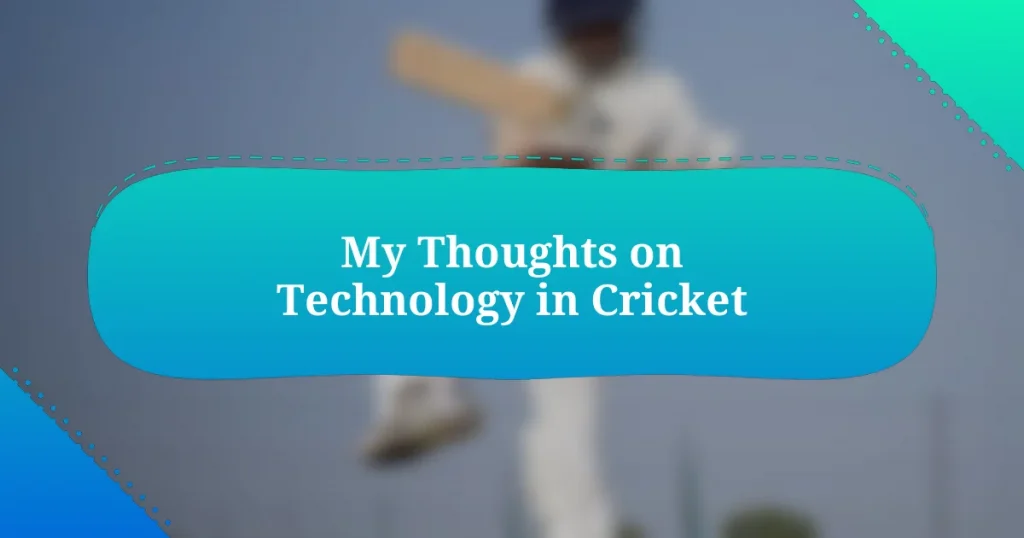Key takeaways:
- Cricket’s history spans from the 16th century in England to a globally celebrated sport, evolving through significant milestones like the inception of Test cricket in 1877 and limited-overs matches.
- Technological advancements such as Hawk-Eye and DRS have transformed decision-making and gameplay, enhancing accuracy and adding excitement for viewers.
- The integration of data analytics and wearable technology is reshaping player training and team strategies, significantly impacting performance analysis.
- The future of cricket technology is poised for innovations like augmented reality and artificial intelligence to deepen fan engagement and improve talent identification.
History of cricket overview
Cricket has a rich history that traces back to the 16th century in England, evolving from a simple pastime into a globally cherished sport. I often find myself reflecting on how the game has transformed over the centuries, from its origins in village green matches to the grandeur of international tournaments. Doesn’t it amaze you how something so humble can become a significant part of many cultures worldwide?
As someone who’s played cricket since childhood, I can vividly recall gathering with friends on weekends, under the sun, imitating our heroes. The game’s historical journey has mirrored my own experiences, highlighting both the beauty of strategy and the thrill of athleticism. Whether it was the birth of Test cricket in 1877 or the introduction of limited-overs matches, each era brings a wave of nostalgia and excitement.
From its establishment in England to its spread across continents, cricket has woven itself into the fabric of society, influencing not just sports but also camaraderie and national pride. It’s intriguing to consider how cricket has adapted through social changes, embracing technology and innovation while maintaining its core traditions. Isn’t it fascinating how a sport continues to resonate, telling stories of passion and identity through each generation?
Evolution of technology in cricket
The integration of technology in cricket is a journey of gradual transformation. Initially, the game was played with simple equipment, but as time went on, innovations like improved bat designs and advanced protective gear began to elevate the players’ performance and safety. I remember the first time I held a modern bat; it felt lighter and more powerful than those clunky ones we used as kids—it was a game-changer.
Moving forward, the real revolution came with the advent of television and broadcasting. The introduction of TV replays, and later Hawk-Eye technology, allowed fans to witness the game from angles previously unimaginable. I still recall the moments of suspense when a close call was under review—those pauses heightened the drama. It prompted me to think: how would that sense of anticipation feel without modern technology?
Today, technology continues to evolve at a rapid pace. The use of data analytics, player tracking, and artificial intelligence now shapes team strategies and player training. As I ponder this ongoing evolution, I can’t help but wonder how future innovations will further change the game. Will we one day have virtual reality experiences that allow fans to step into the shoes of their favorite players? The possibilities seem endless, and it’s exciting to imagine where cricket will go next.
Key technological advancements in cricket
Hawk-Eye technology has transformed the way decisions are made on the cricket field. I remember watching a match where a bowler appealed for LBW, and the replays showed the ball just clipping the edge of the bails. It struck me how this technology not only ensured accurate decisions but also added an exciting layer of suspense for viewers. Can you imagine the outcry if we relied solely on the naked eye for such crucial calls?
Another significant advancement is the DRS, or Decision Review System, which empowers players to challenge on-field decisions. I’ve seen countless matches where teams have successfully overturned controversial calls using this system, changing the course of the game. It made me think—how often have I debated umpire choices with friends, only to wish we had the tech to clarify things right away?
The introduction of wearable technology has also been a game-changer for player fitness and performance analysis. I recall the thrill of watching athletes pushing their limits, all while data on their heart rates and movement patterns was being collected in real time. This data not only enhances their performance but offers fans deeper insights into the physical demands of the game. Isn’t it fascinating how these advancements connect us to the athletes, allowing us to appreciate their dedication even more?
Impact of technology on gameplay
The impact of technology on gameplay is profound, particularly with the advent of ball-tracking systems like Hawk-Eye. I vividly remember a tense match when an appeal for a catch went up, and the on-field decision was unclear. Watching the technology replay that moment, with the ball’s trajectory plotted out, made me appreciate how technology not only clarifies tricky situations but also adds a layer of drama that gets fans on the edge of their seats. Isn’t it incredible how we can now relive pivotal moments with precision?
Furthermore, the use of ultra-motion cameras has enhanced our understanding of player techniques and strategies. During a recent game, I found myself mesmerized by a slow-motion replay of a fast bowler’s delivery. The way the ball spun and seamed was nothing short of artistry. This level of detail not only helps coaches refine skills but also gives us fans a glimpse into the intricate mechanics behind a seemingly simple delivery. Don’t you find it amazing how such technology can change the way we appreciate the athletes’ craft?
Adopting data analytics has shifted team strategies as coaches now rely on insights generated from player performance. I often think back to a particular match where the coach’s real-time adjustments led to a surprising victory due to data-backed decisions. It really highlights how data is shaping not just how cricket is played, but how we engage with every match. Have you ever considered how a single statistic can influence the outcome of a game? It’s a testament to how intertwined technology has become with the essence of cricket.
Personal insights on cricket technology
When it comes to personal insights on cricket technology, I often reflect on my experiences watching games enhanced by the use of DRS (Decision Review System). There was a match I followed closely where a contentious LBW decision completely turned the tide. Seeing the players huddle nervously as the screen displayed the ball-tracking technology recalibrating was electrifying. It felt like a suspenseful scene from a movie, reminding me how critical technology has become in maintaining the integrity of the game.
I also can’t help but think about how wearable technology, like smartwatches and sensors, is transforming player training. During a visit to a local cricket academy, I watched young cricketers use these devices to monitor their fitness levels and batting techniques. Witnessing their eagerness to analyze their performance gave me a glimpse into the future of cricket. How empowering must it feel for these players to receive immediate feedback and make adjustments, much like how athletes in other sports have been doing for years?
Lastly, the introduction of 3D visualization tools for pitch analysis captivates my imagination. I recall a conversation with a seasoned coach who expressed how this technology not only informs their game strategy but also keeps fans engaged with a deeper understanding of conditions affecting play. Watching a graphic that illustrates how the pitch evolves over the course of a day stirred a new level of appreciation in me for the subtleties of the game. Isn’t it fascinating how we can now analyze factors that previously went unnoticed during matches?
Future trends in cricket technology
The future of cricket technology promises even more immersive experiences for fans and players alike. I recently envisioned matches where augmented reality (AR) overlays enhance viewing, enabling spectators to see player statistics and live analytics as if they were part of the game. Just imagine the excitement of watching a live game and, with a simple glance, being able to see a player’s historical performances or even pitch conditions—how cool would that be?
Another intriguing aspect is the growing role of artificial intelligence (AI) in analytics. During one of my discussions with a data analyst, I learned that AI could revolutionize how teams identify talent and craft strategies. They could analyze vast amounts of performance data to predict outcomes or player potential with unprecedented accuracy. It made me think—what if this kind of insight had been available during the early days of cricket? The game might have evolved in an entirely different direction.
As technology advances, I can imagine a future where fan engagement deepens through interactive apps that incorporate real-time data and behind-the-scenes content, making every match feel like a personal experience. I remember the palpable energy at a stadium when fans would rally behind a team, but what if they could influence certain aspects of the game, like training drills or player choices? This idea really excites me—how much more connected would fans feel to their teams?




